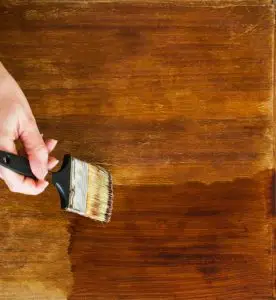Table of Contents
Introduction
If you work with wood as a carpenter or maybe you are a hobbyist, and you are into fabrication, the chances are that you have stressed over the type of finish to apply. You need to apply the proper type of finish to your woodwork projects to protect them from moisture and sunlight to ensure its longevity; makes the paint last longer and keep it vibrant.
“What is a polycrylic?” the polycrylic finish is a derivative of the polycrylic acid. Polycrylic is a type of water-based finish that a lot of people use. Depending on your taste and your need, you can get a polycrylic finish as either satin, semi-gloss or high gloss finish.
If you want a finish that will protect your project properly by providing resistance against water damage and resist other elements, then you should try a polycrylic finish. If you ask your local community of woodworkers or hobbyists, you’ll find that polycrylic finishes come highly recommended.
Types of Polycrylic
The main types of polycrylic finish are aerosol and roll-on.
If you have a small area to cover, go for the polycrylic spray. The aerosol affords you the ability to apply finish to your project quickly; it is easier to apply than the roll-on, which makes it a great option for hobbyists. Although polycrylic dries fast, the spray dries even faster since you’ll be applying a thin layer.
Are you undertaking a large project? Or maybe you are a carpenter then you will need to invest in a roll-on polycrylic finish. It comes in a can and is a larger quantity than sprays. You apply the roll-on like you are applying paint, it takes skill to apply the polycrylic properly to avoid visible brush strokes and ensure an even distribution of the finish.
Whichever type of polycrylic you apply, the wood you’re applying it on will be well protected.
How to Apply Polycrylic
You have to fill all cracks, and repair any faults on the wood. After repairs, you have to clean the surface and make sure there is on dirt, dust or debris on it. While repairing the surface of the wood, use a stainable wood filler, check Best Stainable Wood Filler
Use a high-grade bristle brush to apply the polycrylic on the surface, and apply in a single direction. Apply just a thin layer at once and reapply two or three more coats to ensure even distribution and prevent dripping.
If you are using an aerosol, follow the steps above before you begin the application. Hold the canister about a foot away from the surface, and apply a thin layer.
You can also apply the finish on a painted surface. To apply it on paint, lightly sand the painted surface because it’ll be hard for polycrylic to stay. Be careful while you are sanding to prevent scuffing the wood. After sanding the painted surface, apply the polycrylic in a thin layer.
Here’s a tip when you want to apply polycrylic on paint, apply about three coats of paint since you will be sanding a part of it. Also, use fine sandpaper to prevent ruining the paint.
Benefits of Polycrylic
Why should you use polycrylic instead of another finish like polyurethane?
Polycrylic is a very durable finish; it is easy to maintain, and affordable compared to some finishes. One of the things to check when you want to apply a finish is whether it causes discolouration or not; polycrylic doesn’t leave behind yellow stains as you’ll get from oil-based finishes, rather it is clear.
Polycrylic finish is less toxic than other types of finish; also, it doesn’t smell as bad. One of the downsides to using polycrylic is that it is not easy to apply an even layer; it is runnier so you may have a lot of drips.
The other finish often used besides polycrylic is polyurethane. Polyurethane is an oil-based finish with a water-based variant, unlike solely water-based polycrylic. Professionals use both polyurethane and polycrylic to protect surfaces.
Oil-based polyurethane is ideal for wooden floors, outdoor furniture and other heavy use furniture. It is very tolerant of high temperatures compared to the water-based variant; oil-based polyurethane is the most durable finish between polycrylic and water-based polyurethane.
Polycrylic urethane is often suited to large surfaces and large scale projects.
Conclusion
Polycrylic is a popular type of finish for woodwork. As a water-based finish, it is an excellent choice of finish for your wood project. It is relatively cheap, which makes it suitable for non-professionals since it would be wasteful to spend too much if you are a DIYer. Also, when working indoors, it is best if you use polycrylic because it is less toxic than polyurethane, and it dries faster.
If you are a professional, you may opt for an alternative to polycrylic, which is polyurethane. Be careful when handling polyurethane because it is very flammable in liquid form. Wear protective gear, especially respiratory protection, when using aerosols an oil-based polyurethane.

